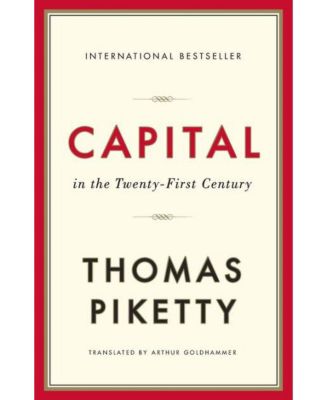Capital in the Twenty-First Century by Thomas Piketty
Product details
Web ID: 5364944How the Very Rich are Very Different from You and
"Let me tell you about the very rich. They are different from you and me," F. Scott Fitzgerald wrote first in a 1925 short story ("Rich Boy") and reprised in a 1938 story ("All The Sad Young Men"). This is one of the major keynotes that drives the observations and conclusions of Thomas Piketty's new work, "Capital in the Twenty-First Century." His work is both an economic and social science approach to analyzing how human behavior has and has not changed very much since the 18th century and perhaps for a much longer period of time - if accurate data resources were available to support his quantitative and graphic presentations. Translated from the French, Piketty's study is a refreshing, sometimes frustrating detailed examination of the dynamics for capital, labor and income over the past three centuries and what his observations suggest might happen in the current century. He opens with a quick, incisive review of the major historical economic theory figures - Smith, Malthus, Ricardo, Marx, even Keynes - pointing out that much of their discussion was not based on quantitative data but simply personal observation or speculation. Ah, the good old days! Only following World War II does sufficient quantitative data become available to ground observations more in fact than opinion. It is using this recent information and painstakingly pulling together data from various "real" sources that Piketty presents the broader picture of economic and social evolution. After the Introduction, the book breaks into four sections: (a) The relationship between capital (buildings, machinery, infrastructure as well as financial instruments but not land and natural resources which are not man-made but added to capital define "wealth") and income which determines the rate of return on capital (b) The dynamics of the capital/income ratio throughout history and the relationship of capital to labor (as "human productivity") (c) The structures of inequality for capital, labor and the concentration of wealth through inheritance (d) Scenarios for regulating capital to achieve a more equitable distribution of capital Some of Piketty's basic observations are pretty interesting and important to consider: - Despite population growth (longer life spans, better health care) global economic growth is about 1 - 1.5% annually and has been at that rate for a long period of time - even adjusting for inflation; - Global output has been generated approximately 70% from labor and 30% from capital - clearly with local variations; - The annual rate of return on capital has varied but had some consistency around 5%, thus, the return on labor has been close to 0%, i.e. a person consumes their wages unless they have accumulated some capital to invest; - If a person has capital and can live on less than the total annual return, say 80%, the remaining capital will accumulate and grow exponentially unless destroyed by major calamities such as war; - Until the introduction of income and, to some extent, capital or inheritance taxes in the early 20th century, capital could be perpetuated through inheritance, excluding individual deviation, hence, become more concentrated among less people; - During the end of the 19th century, or the "Belle Epoque" in Europe and the "Gilded Era" in the U.S., the concentration of capital/wealth ownership among the top 10% of the population may have been as high as 90% and the top 1% owned 45 - 50% - meaning 90% of the remaining population shared 10% of the wealth; - In addition to the introduction of taxes, the impact of two world wars and a deep economic depression dissipated the concentration of wealth among so few - for a while - but with the reduction of tax rates in the 1980s the concentration has quickly resumed and is approaching the levels of the late 19th century. However, there have been some changes from the 19th century economic and social environment besides introduction of taxes and decline in inheritance levels: - As a reaction to the impact of two world wars and the depression, the share of the national or global wealth for the top decile is now closer to 60 - 65% of total wealth that is slightly more dispersed creating a "patrimonial class"; - Additionally, post World War II has seen the rise of "Supermanagers" with large compensation packages presumably based on merit or "luck" (and unchecked by Boards of Directors) partially replacing those with substantial inherited wealth; - The elements of the capital mix have shifted from substantial land holdings to more financial instruments and investments and with that shift has come more competition among countries to attract capital investment by offering higher interest, or rate of return, for wealthy investors; - The impact of inheritance has returned as result of the aging population, namely, if people inherit large sums they do so later in life (50's) since those leaving funds are living longer (80's). This allows the wealth to increase over a longer period of time - assuming the those leaving the funds do not withdraw at an annual rate higher than the annual rate of return on their investments; - Finally, in an amusing analysis of university endowments Piketty shows that the substantial funds such as those for Harvard, Yale and Princeton can actually achieve a higher return than more modest but still large college endowments because of larger operating budgets attracting better qualified managers and investment opportunities with better potential returns. The same principle applies to individual investors in the top centile and even smaller group of extremely wealthy people. Lest one think these conditions apply largely to more developed Western European countries and the United States, Piketty asserts that the faster growth rates seen for China and India as well as other emerging economies are short-term "catch up" development before the greater dynamics of the different rates for capital and the general economy are established. Based on recent reports on the slowing of Chinese growth this view may be plausible. The last major national economies to achieve this growth rate equilibrium are likely to be in Africa. Piketty further speculates as much as a 4% difference for calculating balances for global economic output may be due to tax shelter holdings by the super-rich oligarchs from Russia and the Middle East as well as other private investors. In his final section the author sets forth broad concepts, their strengths and drawbacks for addressing the global inequality of wealth and income. The key concept is a progressive tax on capital requiring international agreement and cooperation to be effective. Piketty admits this idea is a long shot. Unfortunately, he does not address the public distrust of elected and appointed government officials to administer the funds and the media's ability to fan the fires of suspicion. The alternative would appear to be to repeat history and for the public to return to the barricades. Piketty's writing style is both charming and vexing. He makes liberal references to Balzac, Austen and Henry James in wonderful detail to demonstrate how contemporary authors really understood the social impact and consequences of capital and income on a personal level. At other times he debates at excruciating length the merits of data he has looked at to validate a point of view - almost to the point of confusion. Personally, I ignored the few formulas and lengthy discussions about source materials to concentrate on the concepts and their implications. It certainly made the reading faster and more interesting. The book or study is well worth taking the time to explore and will leave a reader with plenty to chew on after this substantial meal. Ernest Hemingway is said to have brusquely responded to F. Scott Fitzgerald's comment about how the rich are different: "Of course they are...they have more money." True but incomplete. As Piketty presents, they also have access to better information, better managers as well as stronger capability to absorb risks, hence, better returns so they keep on accumulating.
Recommends this product
Customer review from barnesandnoble.com


